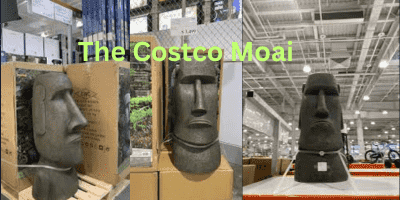The Costco Moai has captured the curiosity and fascination of many by combining ancient cultural heritage with modern-day retail phenomena. In this comprehensive guide, we explain in detail the origin, significance, and fascinating story behind the Costco Moai.
Our aim is to provide a detailed exploration that not only satisfies your curiosity but also provides in-depth insight into this unique blend of history and modernity.

Origin of Moai Statues
Moai statues are monolithic human figures carved by the Rapa Nui people on Easter Island in eastern Polynesia between 1250 and 1500 AD. These statues, which stand on stone platforms called ahu, were built in honor of important ancestors.
The statues are characterized by their large heads, which make up about one-third of the size of the entire statue. The largest Moai, called Paro, stood nearly 10 meters high and weighed 82 tons.
Cultural Significance of Moai Statues
Moai statues are not just historical artifacts; They are deeply ingrained in the cultural and spiritual life of the Rapa Nui people. Each statue represents an ancestor revered as a deity, and they were placed facing out over villages, to watch over the people.
This cultural reverence underscores the importance of the moai in understanding the social structure and religious practices of the Rapa Nui civilization.
The Journey from Moai to Costco
In an unexpected and interesting turn of events, the moai statues have found a new place in the contemporary world, specifically at Costco.
The journey of these iconic statues from remote Easter Island to the aisles of the global retail giant is a story of cultural diffusion, commercial interest, and modern-day fascination with ancient art.
This transformation has sparked debate over cultural appropriation, preservation, and the commercialization of sacred artifacts.
Costco’s Replica Moai: A Modern Interpretation
Costco’s decision to sell replica statues of the moai has astonished and puzzled many. These replicas are not mere decorations; they symbolize the intersection of ancient culture with modern consumerism.
The replicas are carefully crafted to look identical to the original moai statues, maintaining the same impressive appearance and intricate detailing that characterize the authentic statues.
Why the Costco Moai Draws Attention
The Costco moai statues have become a topic of discussion for several reasons. First, their presence in a retail setting highlights the widespread appeal and enduring mystery of the moai. Secondly, they serve as evidence of human fascination with ancient civilizations and their artistry.
Finally, the statues offer a unique aesthetic appeal, making them desirable to those who want to add a touch of historical grandeur to their homes.
The Ethical Debate Surrounding the Costco Moai
The sale of moai replicas at Costco has sparked an ethical debate about cultural sensitivity and appropriation. Critics argue that selling replicas of sacred statues diminishes their cultural and spiritual significance.
However, supporters see it as a way to educate people about the moai and generate interest in Polynesian culture. This debate highlights the broader issue of how ancient artifacts are treated and represented in modern times.
Cultural Awareness and Responsibility
When purchasing a moai replica, it is important to purchase with a sense of cultural awareness and responsibility. Understanding the history and significance of the moai can lead to a deeper appreciation and respect for the Rapa Nui culture.
Buyers should recognize that these replicas represent a culture with a rich and profound history, and they should be treated with the respect they deserve.
Conclusion
Costco moai statues are not simply retail items; they are symbols of a rich cultural heritage that spans centuries. By bringing these replicas into their homes, consumers have the opportunity to connect with a part of history and contribute to the ongoing conversation about cultural preservation and respect.
FAQ About Costco Moai
What are Moai Statues?
Moai statues are monolithic human figures that the Rapa Nui people carved on Easter Island between 1250 and 1500 AD. They were created to honor important ancestors and their large heads are their hallmarks.
Why are Moai statues important?
Moai statues hold cultural and spiritual significance for the Rapa Nui people. Each statue represents a deity and was placed to watch over villages, highlighting their role in social and religious practices.
How did the Moai statues get to Costco?
Costco sells replica Moai statues, which symbolize the intersection of ancient culture with modern consumerism. These replicas are carefully crafted to resemble the original statues, sparking both fascination and debate.
Are the Moai Statues at Costco Authentic?
The moai statues sold at Costco are replicas, not authentic artifacts. They are designed to resemble the original moai statues in detail and appearance.
Why is there an ethical debate about selling moai replicas?
The ethical debate focuses on cultural sensitivity and appropriation. Critics argue that selling replicas of sacred statues diminishes their cultural significance, while supporters believe it helps educate the public and generate interest in Polynesian culture.
How should one approach purchasing a moai replica?
When purchasing a moai replica, it is important to approach with cultural awareness and responsibility. Understanding the history and significance of the moai can foster a deeper appreciation and respect for the Rapa Nui culture.
What impact do moai replicas have on cultural preservation?
The sale of moai replicas can contribute to the ongoing conversation about cultural preservation and respect. By engaging with these replicas, consumers have the opportunity to learn about and appreciate the rich cultural heritage of the Rapa Nui people.